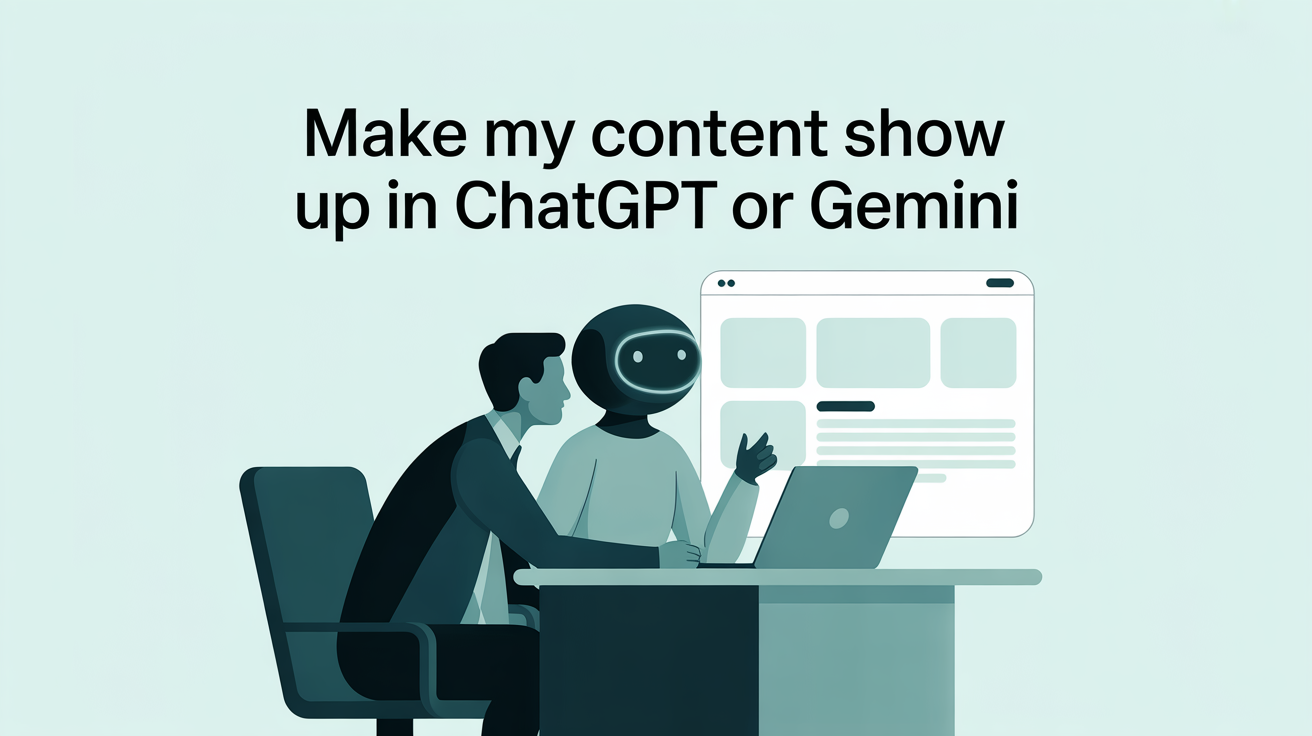How Can I Make My Content Show Up in AI Search Like ChatGPT or Gemini?
AI Search • Nov 11, 2025 1:30:08 PM • Written by: Kelly Kranz

To appear in AI search results, structure your content for how large language models (LLMs) understand and cite information — not just how humans read it. Use clear, question-based headings, factual context, schema markup, and concise direct answers that AI systems can quote accurately.
Frequently Asked Questions
How can I make my content show up in AI search like ChatGPT or Gemini?
To appear in AI search results, structure your content for how large language models (LLMs) understand and cite information. Use clear, question-based headings, factual context, schema markup, and concise direct answers that AI systems can quote accurately.
How does AI search work compared to traditional search?
AI search engines like ChatGPT, Gemini, and Perplexity don’t rely on keyword crawling. They interpret meaning and prioritize sources that provide direct, structured, and credible answers. AI search is answer-driven, not link-driven.
How do ChatGPT and Gemini choose sources?
ChatGPT and Gemini favor content that is clearly structured, credible, and marked up with schema. They prioritize sources with direct answers, semantic headings, consistent terminology, and author credibility.
What is the difference between SEO and AIO (AI Optimization)?
Traditional SEO focuses on ranking for clicks, while AIO aims to make your content a trusted source for AI-generated answers. SEO relies on keywords and backlinks, while AIO focuses on semantics, schema, and credibility to help LLMs understand your content.
What are the steps to make my content discoverable in AI search?
To optimize for AI search, follow these steps: 1) Lead with a clear direct answer. 2) Structure content semantically with question-based headings. 3) Add FAQ or HowTo schema markup. 4) Strengthen internal context links. 5) Use credible references from trusted sources.
What are common mistakes that reduce AI visibility?
Common mistakes include long intros before the main answer, keyword-heavy headers without clear intent, missing schema markup, weak internal linking, and generic phrasing that lacks authority. Content should be predictable and structured for AI comprehension.
How can I measure AIO performance?
Measure AIO performance through metrics like zero-click mentions, AI citations, content recall in model outputs, and visibility consistency across AI platforms. Traditional SEO metrics like rankings or CTR don’t reflect AI visibility effectively.
Can I force ChatGPT or Gemini to quote my content?
You can’t force AI systems to quote your content, but you can make it easier for them to do so by structuring information clearly, using schema markup, and providing authoritative, concise answers that models can confidently reference.
Understanding How AI Search Works
AI search engines like ChatGPT, Gemini, and Perplexity don’t crawl pages for keywords the way traditional search does.
They interpret meaning and select sources based on:
- How directly your content answers a question
- The clarity and structure of your sections
- Presence of trustworthy signals (citations, schema, data)
- Whether your brand or content is semantically linked to a topic
AI search is answer-driven, not link-driven — visibility depends on how easy it is for AI to understand, extract, and cite your information.
How ChatGPT and Gemini Choose Sources
Both ChatGPT and Gemini rely on retrieval systems that prioritize clarity, structure, and credibility.
In practice, they favor content with:
- Structured context — clear H2/H3 headings, question-answer sections, short paragraphs.
- Schema markup — FAQ and Article schema help AI understand meaning.
- Author credibility — visible expertise, consistent tone, cited data.
- Entity clarity — consistent terminology like “AI Optimization (AIO)” across pages.
When your content checks these boxes, it’s more likely to appear as a cited or summarized source in AI-generated answers.
Traditional SEO vs. AIO (AI Optimization)
Unlike SEO, which focuses on ranking in search results, AIO is about becoming the source AI engines rely on when generating answers.
Here’s how the two approaches differ:
| Aspect | Traditional SEO | AI Optimization (AIO) |
|---|---|---|
| Goal | Rank for clicks | Be cited in AI answers |
| Primary User | Human searchers | Large Language Models |
| Optimization Focus | Keywords and backlinks | Semantics, schema, and credibility |
| Measurement | Impressions, traffic, CTR | AI citations, zero-click mentions, model recall |
5 Steps to Make Your Content Discoverable in AI Search
Adopt these AIO-aligned practices from AI Marketing Labs’ AIO Checklist to improve how AI understands your brand:
- Lead with a Direct Answer. Start every article with a sub-50-word summary that clearly answers the question in your title. Why it works: AI tools often extract the first clear, factual paragraph to generate summaries.
- Structure Semantically. Use H2 and H3 headings phrased as natural questions to help LLMs match your content to user intent.
- Add Schema Markup. Include FAQ and HowTo schemas (where relevant) to make your content machine-readable and easy for AI to cite.
- Strengthen Context Links. Internally link to related resources to build authority around your topic cluster.
- Use Credible References. Cite reputable data, studies, or brand-owned research. AI models weigh credibility when choosing sources.
Common Mistakes That Reduce AI Visibility
- Long intros before the main answer
- Keyword-heavy headers without clear intent
- Missing or incorrect schema markup
- No internal linking or topical clustering
- Generic phrasing that doesn’t convey authority
The more predictable and structured your content feels to an AI reader, the more likely it is to be surfaced in conversational results.
How to Measure AIO Performance
AI visibility isn’t about traditional ranking reports. Instead, track performance in new ways:
- Zero-click mentions — when your content is cited or summarized without a user clicking through.
- AI citations — check tools like Perplexity, ChatGPT, or Gemini for your brand mentions.
- Content recall — whether your pages appear in LLM outputs when users ask relevant questions.
- Visibility consistency — how often your content is referenced across multiple AI platforms.
For more on tracking performance beyond SERP rankings, see Tracking AIO Performance Metrics.
Final Thoughts
You can’t force ChatGPT or Gemini to quote your content — but you can make it easy for them to want to. By combining structure, schema, and credible answers, your brand becomes a trustworthy source for AI-driven results. That’s the essence of AIO: optimizing not just for clicks, but for comprehension.
The AIO System
S E A R C H H A S C H A N G E D.S O S H O U L D Y O U R C O N T E N T S T R A T E G Y.
Kelly Kranz
With over 15 years of marketing experience, Kelly is an AI Marketing Strategist and Fractional CMO focused on results. She is renowned for building data-driven marketing systems that simplify workloads and drive growth. Her award-winning expertise in marketing automation once generated $2.1 million in additional revenue for a client in under a year. Kelly writes to help businesses work smarter and build for a sustainable future.

